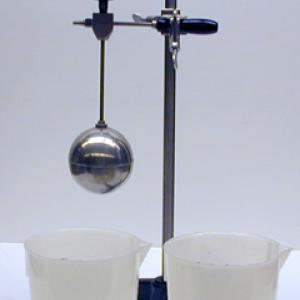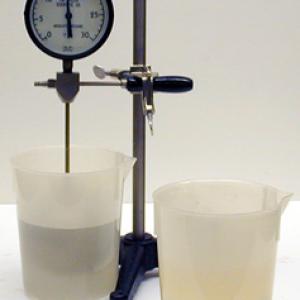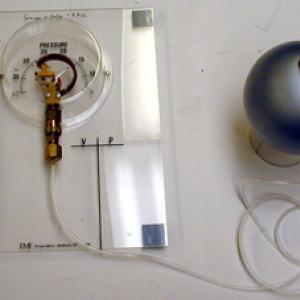College of Liberal Arts & Sciences
4E30.10 - Constant Volume Bulb - Absolute Zero Apparatus
When the metal flask is put into the different temperature water baths a large needle fluctuation should be observed. CO2 in alcohol may be substituted for the water ice bath but care MUST be observed due to the fire hazards. Plotting Temperature VS Pressure of different gases should allow you to make a determination of Absolute Zero.
The regular Boyle's Law Apparatus can be adapted to studies of Absolute Zero with the addition of the optional Absolute Zero Bulb. Once properly set up and checked for leaks at the quick connect coupler, the apparatus is used in the same way as the constant volume bulb described above.
Liquid nitrogen may be used to cool this device.
HOWEVER, care must be taken not to hold the bulb in the liquid nitrogen too long as this may crack the seam.
- Nelson Kilmer and Joel D. Krehbiel, "Improved Gay-Lussac Experiment Considering Added Volumes", TPT, Vol. 57, #1, Jan. 2019, p. 21.
- Jeffrey D. Goldader, "Determining Absolute Zero Using a Tuning Fork", TPT, Vol. 46, #4, Apr. 2008, p. 206.
- Dean S. Edmonds Jr., "Comments on Determination of Absolute Zero", TPT, Vol. 41, #6, Sept. 2003, p. 318.
- Dragia Trifonov Ivanov, "Experimental Determination of Absolute Zero Temperature", TPT, Vol. 41, #3, Mar. 2003, p. 172.
- Gavin D. Peckham, "P-V Diagrams Have More to Offer", TPT, Vol. 35, #1, Jan. 1997, p. 56.
- Barbara S. Andereck, "Colder than Zero?", TPT, Vol. 29, #8, Nov. 1991, p. 485.
- Robert Otani and Peter Siegel, "Determining Absolute Zero in the Kitchen Sink", TPT, Vol. 29, #5, May 1991, p. 316.
- Michael D. Edmiston, "Boiling, Bubbles, and Pressure", TPT, Vol. 27, #3, Mar. 1989, p. 136.
- Thomas O. Callaway and Harry D. Downing, "Response", TPT, Vol. 27, #3, Mar. 1989, p. 136.
- G. T. Clayton, T. O. Callaway, and H. D. Downing, "Experiments with Disposable Hypodermic Syringes", TPT, Vol. 26, #1, Jan. 1988, p. 19.
- Harvey S. Left, "Heat Engines and the Performance of External Work", AJP, Vol. 46, #3, Mar. 1978, p. 218.
- Caroline Delbert, "This Is The Closest Scientists Have Gotten to Reaching Absolute Zero", Popular Mechanics, March/April 2022, p. 32.
- A. Mason Turner, "Boyle's Law and Absolute Zero", EME Study Guide, Danbury, CT., 1975.
- Ha-4, Hg-1: Freier and Anderson, A Demonstration Handbook for Physics.
- C. J. Overbeck, R. R. Palmer, R. J. Stephenson, and Marsh W. White, Boyle's and Charle's, Selective Experiments in Physics, Central Scientific Company, 1940.
- V. E. Eaton, C. J. Overbeck, R. J. Stephenson, and Marsh W. White, "Charles' Law", Selective Experiments in Physics, Central Scientific Company, 1940.
- C. J. Overbeck, R. R. Palmer, R. J. Stephenson, and Marsh W. White, "Expansion of Gases", Selective Experiments in Physics, Central Scientific Company, 1940.
- C. J. Overbeck, R. J. Stephenson, and Marsh W. White, "Charles' Law", Selective Experiments in Physics, Central Scientific Company, 1959.
Disclaimer: These demonstrations are provided only for illustrative use by persons affiliated with The University of Iowa and only under the direction of a trained instructor or physicist. The University of Iowa is not responsible for demonstrations performed by those using their own equipment or who choose to use this reference material for their own purpose. The demonstrations included here are within the public domain and can be found in materials contained in libraries, bookstores, and through electronic sources. Performing all or any portion of any of these demonstrations, with or without revisions not depicted here entails inherent risks. These risks include, without limitation, bodily injury (and possibly death), including risks to health that may be temporary or permanent and that may exacerbate a pre-existing medical condition; and property loss or damage. Anyone performing any part of these demonstrations, even with revisions, knowingly and voluntarily assumes all risks associated with them.


